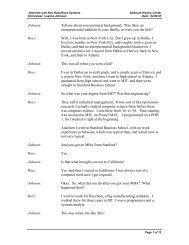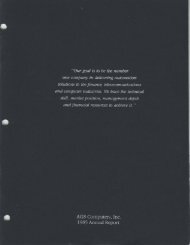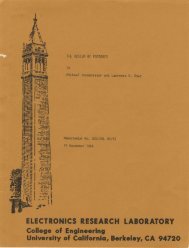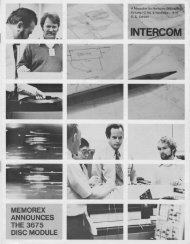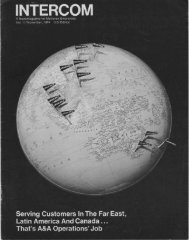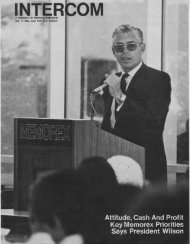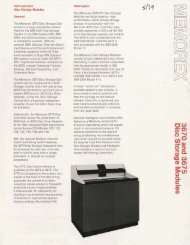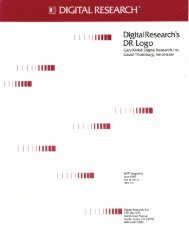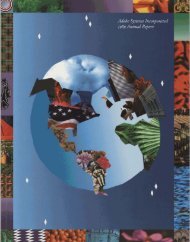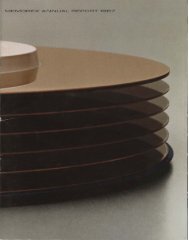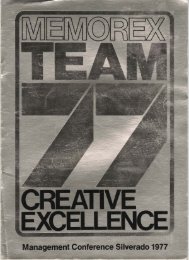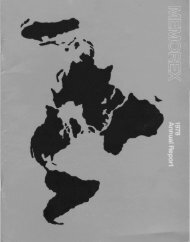Software AG's New Headquarters - the Information Technology ...
Software AG's New Headquarters - the Information Technology ...
Software AG's New Headquarters - the Information Technology ...
You also want an ePaper? Increase the reach of your titles
YUMPU automatically turns print PDFs into web optimized ePapers that Google loves.
A Stitch in Time Saves Nine<br />
Dave Williamson<br />
Utah State Office of Education<br />
If you have installed NATURAL 2<br />
under CICS you have probably<br />
looked for some kind of information<br />
on how to set <strong>the</strong> thread size.<br />
You need to have threads large<br />
enough to handle <strong>the</strong> requirements<br />
of your site but in CICS memory<br />
can be precious and you definitely<br />
don't want to waste it. Since<br />
NATURAL 2 is still relatively new<br />
this type of operational information<br />
has not made it into <strong>the</strong> documentation.<br />
<strong>Software</strong> AG suggests that<br />
you start with 180k threads. Is this<br />
too much or too little for your<br />
shop I believe that <strong>the</strong> following<br />
information may be helpful in determining<br />
what a reasonable thread<br />
size should be for your shop.<br />
First we need to define a couple of<br />
new buffers used in NATURAL 2<br />
and explain how <strong>the</strong>ir size is determined.<br />
The Screen Buffer holds<br />
<strong>the</strong> image of what is on <strong>the</strong> physical<br />
screen and is determined by <strong>the</strong><br />
physical screen size. Its use includes<br />
<strong>the</strong> optimization of data<br />
streams on communications lines<br />
and windowing. To determine <strong>the</strong><br />
size of this buffer use <strong>the</strong> following<br />
formula.<br />
Screen Buffer = line size (of physical<br />
device) x page size (of physical<br />
device)<br />
The Page Buffer holds <strong>the</strong> image of<br />
<strong>the</strong> data on <strong>the</strong> logical screen or<br />
page, it is determined by <strong>the</strong> LS<br />
and PS parameters in <strong>the</strong><br />
NATPARM module or dynamic<br />
overrides. Its use includes windowing<br />
around logical screens that are<br />
larger than <strong>the</strong> physical screens. To<br />
determine <strong>the</strong> size of this buffer use<br />
<strong>the</strong> following formula.<br />
Page Buffer = LS (from NATPARM)<br />
x PS (from NATPARM)<br />
Both <strong>the</strong> Page Buffer and <strong>the</strong> Screen<br />
Buffer have an associated Attribute<br />
Buffer to hold <strong>the</strong> attribute information<br />
for <strong>the</strong> fields in <strong>the</strong> respective<br />
buffer. The attribute buffers size is<br />
influenced inversely by <strong>the</strong> AV-<br />
ERIO parameter in <strong>the</strong> NATPARM<br />
module or dynamic overrides. To<br />
USIZE 32k user buffer<br />
ESIZE 28k user buffer extension<br />
FSIZE 15k NATURAL DDMlsymbol tables<br />
DSIZE lk debug buffer<br />
CSIZE Ok CON-NECT buffer area<br />
5k miscellaneous<br />
Screen Buffer 2k (24 x 80 = 1920)<br />
Page Buffer 8k (60 x 132 = 7920)<br />
Screen Attribute Buffer 4k (1920 x 10 1 5 = 3840)<br />
Page Attribute Buffer 16k (7920 x 10 1 5 = 15840)<br />
lllk required thread size<br />
determine <strong>the</strong> size of <strong>the</strong>se buffers<br />
use <strong>the</strong> following formulas.<br />
Screen Attribute Buffer = Screen<br />
Buffer x 10 1 AVERIO<br />
Page Attribute Buffer = Page Buffer<br />
x 10 I AVER10<br />
To determine <strong>the</strong> a~~roximate required<br />
thread size simply add all of<br />
<strong>the</strong> NATURAL buffer sizes toge<strong>the</strong>r<br />
and throw in an extra 5k for miscellaneous<br />
use. These buffers are <strong>the</strong><br />
Screen Buffer, Page Buffer, Screen<br />
Attribute Buffer, Page Attribute<br />
Buffer, ESIZE, USIZE, FSIZE,<br />
DSIZE, CSIZE. Figure 1 is an example<br />
of this calculation.<br />
Just to make life interesting we<br />
should look at a couple of things<br />
that will affect what thread size you<br />
may really need. If you allow <strong>the</strong><br />
use of dynamic parameters at natural<br />
start up, you will need to take<br />
into account <strong>the</strong> effects of dynamic<br />
Figure 1<br />
parameters by ei<strong>the</strong>r adding a cushion<br />
of a several k or use <strong>the</strong><br />
maximum buffer settings you will<br />
allow in <strong>the</strong> calculations. The later<br />
could have several permutations.<br />
The o<strong>the</strong>r thing is that some of <strong>the</strong><br />
buffers are being used slightly different<br />
than in <strong>the</strong> past. The USIZE<br />
for example is not used for <strong>the</strong> object<br />
code when running NATURAL<br />
2 programs, as <strong>the</strong>y are executed<br />
out of <strong>the</strong> buffer pool. A good description<br />
of how <strong>the</strong> USIZE is used<br />
appears in <strong>the</strong> NATURAL Administrators<br />
Manual. The point is that<br />
you may need to reevaluate <strong>the</strong> settings<br />
of <strong>the</strong>se buffers.<br />
What is really needed is a tool that<br />
can be used to monitor <strong>the</strong> thread<br />
usage just as SYSTAT is used to<br />
monitor <strong>the</strong> buffer pool. Until we<br />
have that kind of tool this information<br />
may help save same memory<br />
that would o<strong>the</strong>rwise be wasted.<br />
<strong>New</strong> Executive Committee Appointees<br />
Bill Wagner<br />
The University of Texas at Austin<br />
Because of <strong>the</strong> Constitutional<br />
changes and <strong>the</strong> elections, <strong>the</strong>re are<br />
now several new faces on <strong>the</strong><br />
Executive Committee. As was anat<br />
<strong>the</strong> Conference' Laura<br />
Jacobs of <strong>the</strong> Rochester Institute of<br />
<strong>Technology</strong> has agreed to be <strong>the</strong><br />
first End User Computing Functional<br />
Area Representative. Colette<br />
Farabaugh of Dole Processed Foods<br />
has accepted appointment to fill <strong>the</strong><br />
vacant position of Vice President,<br />
and Mary Ellen Woods of Inland<br />
Steel will take over Colette's former<br />
duties as Nominations and Elections<br />
Chairperson.<br />
Addresses and phone numbers for<br />
<strong>the</strong>se officers can be found at <strong>the</strong><br />
back of this newsletter. Like <strong>the</strong> rest<br />
of <strong>the</strong> Executive Committee, <strong>the</strong>ir<br />
effectiveness in representing you is<br />
directly related to <strong>the</strong> input <strong>the</strong>y<br />
receive from you. Suggestions,<br />
comments, questions, and criticisms<br />
are always welcome. And of<br />
course, <strong>the</strong> communication lines<br />
flow both ways, as many of you<br />
will find out when you hear<br />
Mary Ellen in <strong>the</strong> months ahead.



